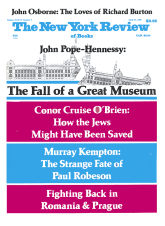In response to:
'Rewriting the Iran-Contra Story': An Exchange from the March 2, 1989 issue
To the Editors:
Theodore Draper is really an amazing phenomenon: he is so intent on discrediting my book, Perilous Statecraft, that he sinks to new lows in misdirection [Letters, NYR, March 2] when he discovers that I agree with him. How else can one explain his denunciation of me for daring to point out that we agree that Casey almost surely was not the inspiration for North’s “off the shelf” covert action program and the “diversion” of money from the Iran Initiative to the contras? He even savages me for quoting Casey’s lawyer in support of (not, as Draper would have it, “to prove”) that conclusion (which is argued over a number of pages).
Then he has at me once again on Ghorbanifar. Like those at CIA who stereotyped Ghorbanifar as a near-total, pathological liar, Draper just can’t bring himself to look honestly at the evidence. For what does Mr. Draper use as proof of Ghorbanifar’s mendacity? He cites the trip to Tehran in the spring of 1986, when “Ghorbanifar was blamed by the Americans for having deceived both sides about what each was prepared to do….”
It sounds good, but it’s wrong, as Draper should have learned by reading Perilous Statecraft, or by simple logic. For if the Americans really believed Ghorbanifar to be a liar, how could they have entrusted the arrangements for a trip as sensitive as the Tehran mission to such a person? They couldn’t, and they didn’t. The arrangements were confirmed in two separate telephone conversations between the CIA’s George Cave, and two top officials of the Khomeini regime in Tehran. So whatever misunderstandings existed can’t fairly be blamed on Ghorbanifar (as North did in his public testimony). And indeed, Cave testified to the Iran-Contra committees that his understanding of the arrangements did not coincide with what North apparently told McFarlane.
So Draper’s bullying words about me—“Michael A. Ledeen is a gambler. He gambles that no one is going to check up on him”—are better applied to himself.
Michael A. Ledeen
Chevy Chase, Maryland
Theodore Draper replies:
Whether he likes it or not, Mr. Ledeen is still gambling:
1. The point at issue in Ledeen’s citation of a statement by Milton Gould, William Casey’s lawyer, is whether it referred to Casey’s attitude toward the “off-the-shelf capability.” I showed that Gould had said nothing more than that Casey had never done anything wrong. Ledeen again falls back on Gould without being able to cite anything to the contrary. If Ledeen could point to anything in Gould’s statement that actually refers to the “off-the-shelf capability,” he should have put it in his present letter. Bluster is not good enough.
- More important is the issue whether Ghorbanifar lied to both sides at key moments—something Ledeen explicitly denied in his book (pp. 192–193). Now Ledeen mentions the evidence given by George Cave, the Farsi-speaking CIA consultant who went on the mission to Tehran. Cave happens to be the one who has given the most telling testimony that Ghorbanifar deceived both sides.
On p. 627 of his deposition, Cave states that Ghorbanifar told the Americans that they would meet with Prime Minister Musavi, Speaker of the Majlis Rafsanjani, and President Khomeini. The Americans were never permitted to meet them. On p. 652, Cave relates that the “senior Iranian” at Tehran “got me aside and showed me letters Ghorbanifar had written, giving them all this stuff that we had never heard about…. It is clear Ghorbanifar was telling the Iranian side one thing and us another.”
It is also clear that Ledeen has not done his homework and is gambling that no one else is doing it.
This Issue
April 27, 1989



